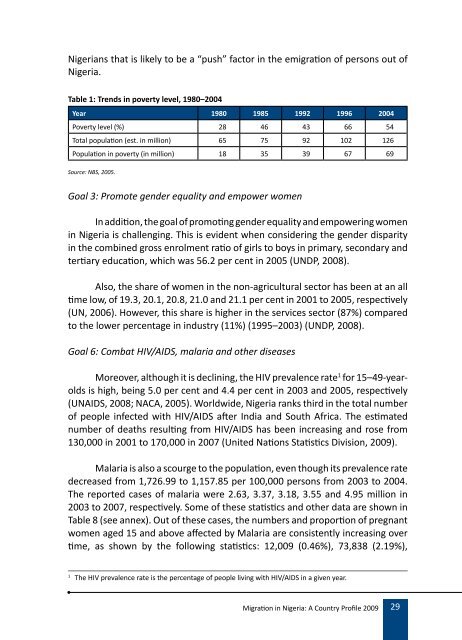Migration Profile on Nigeria - IOM Publications - International ...
Migration Profile on Nigeria - IOM Publications - International ...
Migration Profile on Nigeria - IOM Publications - International ...
You also want an ePaper? Increase the reach of your titles
YUMPU automatically turns print PDFs into web optimized ePapers that Google loves.
<strong>Nigeria</strong>ns that is likely to be a “push” factor in the emigrati<strong>on</strong> of pers<strong>on</strong>s out of<br />
<strong>Nigeria</strong>.<br />
Table 1: Trends in poverty level, 1980–2004<br />
Year 1980 1985 1992 1996 2004<br />
Poverty level (%) 28 46 43 66 54<br />
Total populati<strong>on</strong> (est. in milli<strong>on</strong>) 65 75 92 102 126<br />
Populati<strong>on</strong> in poverty (in milli<strong>on</strong>) 18 35 39 67 69<br />
Source: NBS, 2005.<br />
Goal 3: Promote gender equality and empower women<br />
In additi<strong>on</strong>, the goal of promoting gender equality and empowering women<br />
in <strong>Nigeria</strong> is challenging. This is evident when c<strong>on</strong>sidering the gender disparity<br />
in the combined gross enrolment ratio of girls to boys in primary, sec<strong>on</strong>dary and<br />
tertiary educati<strong>on</strong>, which was 56.2 per cent in 2005 (UNDP, 2008).<br />
Also, the share of women in the n<strong>on</strong>-agricultural sector has been at an all<br />
time low, of 19.3, 20.1, 20.8, 21.0 and 21.1 per cent in 2001 to 2005, respectively<br />
(UN, 2006). However, this share is higher in the services sector (87%) compared<br />
to the lower percentage in industry (11%) (1995–2003) (UNDP, 2008).<br />
Goal 6: Combat HIV/AIDS, malaria and other diseases<br />
Moreover, although it is declining, the HIV prevalence rate 1 for 15–49-yearolds<br />
is high, being 5.0 per cent and 4.4 per cent in 2003 and 2005, respectively<br />
(UNAIDS, 2008; NACA, 2005). Worldwide, <strong>Nigeria</strong> ranks third in the total number<br />
of people infected with HIV/AIDS after India and South Africa. The estimated<br />
number of deaths resulting from HIV/AIDS has been increasing and rose from<br />
130,000 in 2001 to 170,000 in 2007 (United Nati<strong>on</strong>s Statistics Divisi<strong>on</strong>, 2009).<br />
Malaria is also a scourge to the populati<strong>on</strong>, even though its prevalence rate<br />
decreased from 1,726.99 to 1,157.85 per 100,000 pers<strong>on</strong>s from 2003 to 2004.<br />
The reported cases of malaria were 2.63, 3.37, 3.18, 3.55 and 4.95 milli<strong>on</strong> in<br />
2003 to 2007, respectively. Some of these statistics and other data are shown in<br />
Table 8 (see annex). Out of these cases, the numbers and proporti<strong>on</strong> of pregnant<br />
women aged 15 and above affected by Malaria are c<strong>on</strong>sistently increasing over<br />
time, as shown by the following statistics: 12,009 (0.46%), 73,838 (2.19%),<br />
1 The HIV prevalence rate is the percentage of people living with HIV/AIDS in a given year.<br />
<str<strong>on</strong>g>Migrati<strong>on</strong></str<strong>on</strong>g> in <strong>Nigeria</strong>: A Country <str<strong>on</strong>g>Profile</str<strong>on</strong>g> 2009<br />
29

















